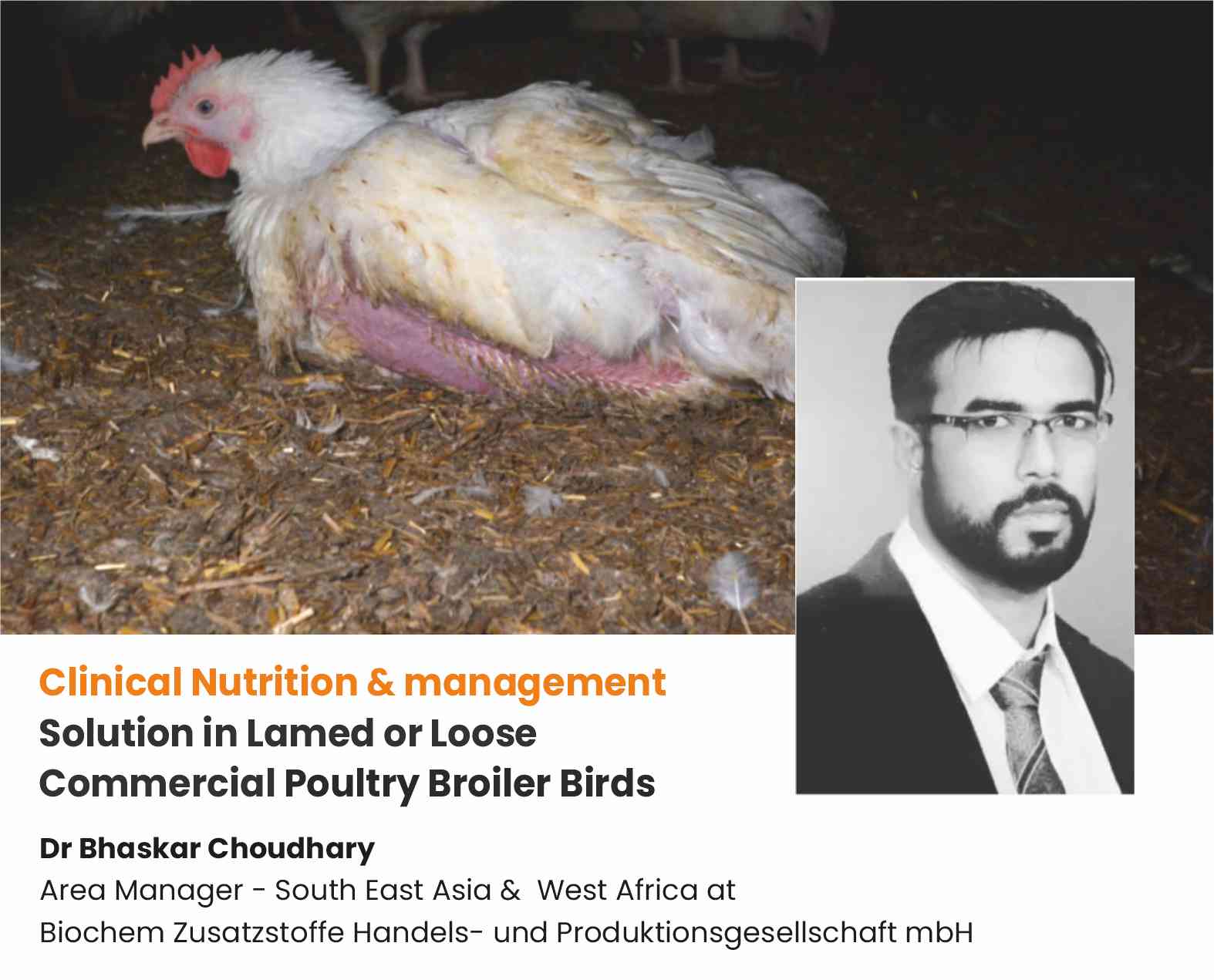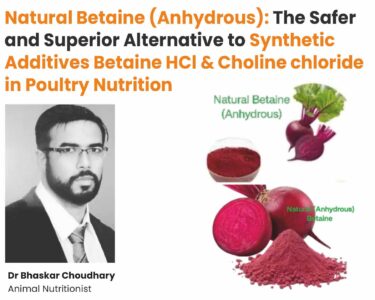Clinical Nutrition & Management Solution in Lamed or Loose Commercial Poultry Broiler Birds

Dr Bhaskar Choudhary
Area Manager – Southeast Asia & West Africa at
Biochem Zusatzstoffe Handels- und Produktionsgesellschaft mbH
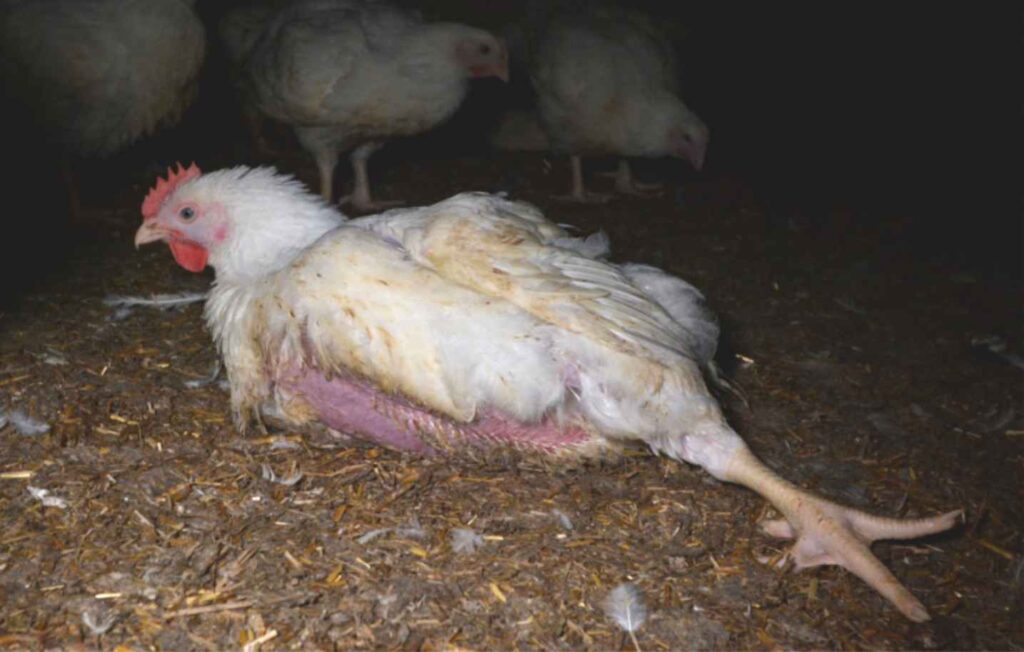
The factors that cause leg weakness, include nutritional deficits, mechanically induced trauma, toxins, genetic defects, pathogens infectious diseases, sex, weight and growth rate, age, the efficiency of feed conversion, handling and movement.
1. Leg weakness and lameness due to genetic & Nutritional imbalance
In field broiler birds we observe that compare to Cobb non cobb breed have high breast meat percentage but simultaneously its micronutrients & macronutrients requirements is high specially in case of change of conventional raw materials in field, since demand of growth rate is high to meet this demand only protein & energy in feed formulation consider while micro & macro nutrients of one accord neglect reason may be.
a. commercial constraint
b. Not having enough information about alternative raw materials.
A well-balanced diet is essential in broilers to prevent leg disorders. For example, a shortage of water-soluble vitamins, manganese, or zinc may lead to the development of shorter bones with valgus abnormalities. In addition, ‘rickets’ can be exacerbated by a lack of nutrients in fast-growing chickens. Small shortages of biotin in feeding schedules caused more footpad dermatitis, liver discoloration due to which vitamin D3 absorption hamper which at the end cause leg weakness.
2. Leg weakness due to management :
a. We are well aware about that quarter of time seem the chickens to sleep and more than half of the time they are just not doing anything. A healthy chicken is on average 76 percent of the time spent lying. This percentage is increased with age, and it is indicated that it is significantly larger with a higher degree of lameness (up to 86
percent) , here 23hour light & 1 hour darkness standard to increase the food intake and growth rate . The light can have an influence on behavior, physiology and well-being in different ways. There are studies that have shown that lameness and growth of chicks is influenced by different light periods .
b. Litter
When housing poultry litter on the ground is well important. A good litter material can be defined as a material that can absorb and give off a lot of moisture back. In practice, wine wood shavings and straw, the most commonly used materials . It was also reported all that chicks that sit on wood shavings show higher activity than those sitting on straw. This could also be an occasion for less lameness.
c. Conditioning (Heating and Ventilation)
The high and low temperature is associated with increased incidence of leg disorders. At a low occupancy is apparent that the air has little influence on the chick quality. At a higher occupancy (20 chicks per m2), however, the climate has an influence the proportion chicks with diseased feet are lower and they are less soiled
d. Occupancy :
The use of high occupancy is far-reaching to economically maximum advantage. Use of the surface however, the capacity is limited by the bad effects that this has on the growth and quality. The occupation has a clear influence on the external quality of the chicks. In the lower occupancy of 16 chicks per m2 is the number of chicks with red heels considerably lower and annotating of the soles is significantly less. Moreover, there are fewer varieties for the chicks less soiled at low stocking densities.
3. Gender: Both sexes have problems of lameness However, the male chicks encountered more problems than the female, even when the body weight is considered.
4. Mycotoxins: Articular Gout and Tibia Dyschonroplasia and the list various bone diseases in broilers possibly caused by mycotoxins. Mycotoxins such as aflatoxin, ochratoxin and fusarium toxin lead to rickets due to their toxic effects on liver and kidney, which consequently prevents the conversion of vitamin D3 and its absorption.
5. Infectious Diseases:
a. Reovirus: It is suspected that the virus can spread through ‘avian egg transmission’, especially since the virus was found in apparently normal embryos from commercial chickens. clinical symptoms are characterized by mild to moderate lameness swollen ‘hocks’ met a noticeable increase of fluid in the “hock” joints.
b. Mycoplasma synoviae : Invisible Mycoplasma Synoviae causes respiratory diseases but can also result in airsacculitis and synovitis in chickens.
c. Staphylococcus aureus: Infection with S. aureus can cause many different clinical features such as septicemia (prevention of pathogenic microorganisms and their toxins in the blood), bone and joint infections, abscesses and dermatitis.
Field Observation:
1. Chondrodystrophie &Tibia dyschondroplasia: Poultry with a shortage of B complex vitamins, Manganese (Mn), can develop shorter bones with varus abnormalities.
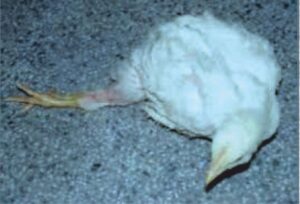
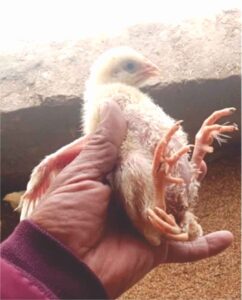
It is observed that Liquid organic minerals & Biotin.
Zinc-40mg/litre
Mn-25mg/litre
Cu-4 mg/litre
Biotin-80 mg/litre

First 10 days 1ml per liter of drinking water in broiler chicken helps in this varus abnormalities.
Femoral head necrosis: These diseases may affect the entire house. The clearest indicator is the inability of the broilers to stand up. When there is an autopsy is carried out on the birds, it is the end of the femur. The broilers can respond to vitamin D3 in the drinking water.
Contact dermatitis: This is a managemental problem due to bad litter effect of ammonium chemical burning in the litter. Contact
dermatitis is clear due to very long time spent for sitting and bad litter. The time that is spent for sitting and lying by the chicks, increases with the age from 75 percent in the first week to 90 percent at five weeks. Footpad dermatitis is a type of contact dermatitis, which is characterized by lesions on the soles of poultry.
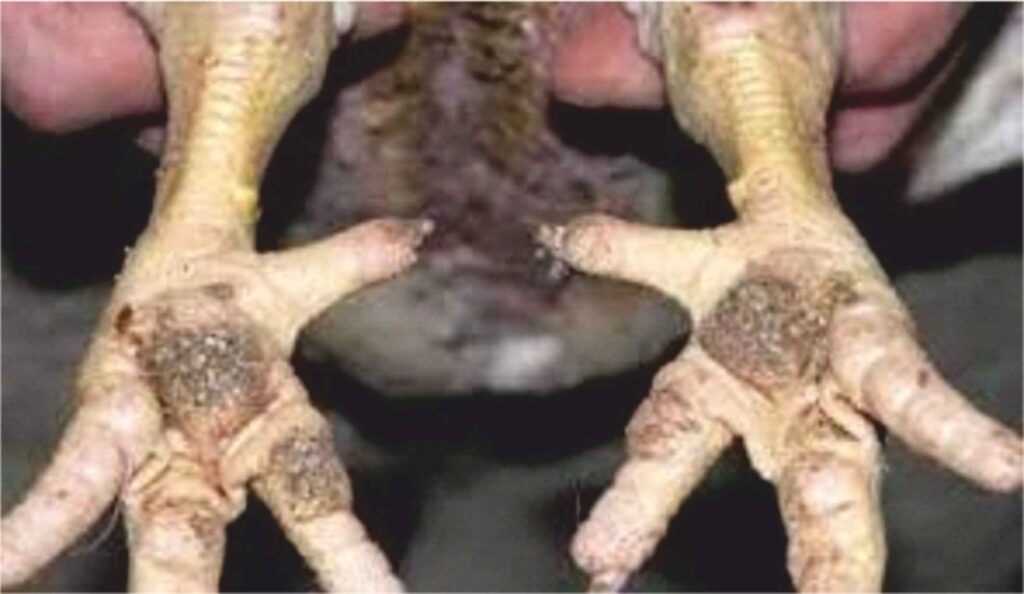
Conclusion:
1. Mycoplasma management where ND & IB titer which need to be managed by proper vaccination schedule & use of eucalyptus oil in drinking water after 12 hour this vaccination so that ND & IB titer improve in birds.
2. Avoid Antibiotics in drinking water & feed the first 10 days unless it is not required for treatment which is mostly used in the field as Agp or yolk absorption (as a myth among farmer) or some field practitioner in 3rd to 5th day for mycoplasma prevention which aggravates the situation.
3. Due to effect of Global warming Mycotoxin threat is worldwide which need to be mange with good multiple toxin binder which have good adsorption & desorption at different pH (pH 2-8.5)
4. Nutritional formulation not only consider protein or energy but also macro & micronutrients specially when consider non-conventional raw materials, in farm application liquid organic minerals Biotin & Vitamin D3 important tool to overcome this nutritional deficiency problems.
5. Lighting, ventilation & litter management in poultry shed is very much essential for proper growth & food pad dermatitis.


